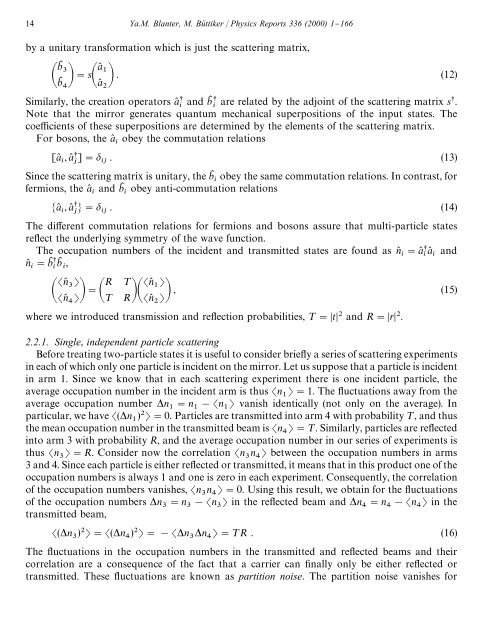shot noise in mesoscopic conductors - Low Temperature Laboratory
shot noise in mesoscopic conductors - Low Temperature Laboratory
shot noise in mesoscopic conductors - Low Temperature Laboratory
You also want an ePaper? Increase the reach of your titles
YUMPU automatically turns print PDFs into web optimized ePapers that Google loves.
14 Ya.M. Blanter, M. Bu( ttiker / Physics Reports 336 (2000) 1}166<br />
by a unitary transformation which is just the scatter<strong>in</strong>g matrix,<br />
bK <br />
bK "s a( . (12)<br />
a( <br />
Similarly, the creation operators a( and bK are related by the adjo<strong>in</strong>t of the scatter<strong>in</strong>g matrix s.<br />
Note that the mirror generates quantum mechanical superpositions of the <strong>in</strong>put states. The<br />
coe$cients of these superpositions are determ<strong>in</strong>ed by the elements of the scatter<strong>in</strong>g matrix.<br />
For bosons, the a( obey the commutation relations<br />
[a( , a( ]" . (13)<br />
S<strong>in</strong>ce the scatter<strong>in</strong>g matrix is unitary, the bK obey the same commutation relations. In contrast, for<br />
fermions, the a( and bK obey anti-commutation relations<br />
a( , a( " . (14)<br />
The di!erent commutation relations for fermions and bosons assure that multi-particle states<br />
re#ect the underly<strong>in</strong>g symmetry of the wave function.<br />
The occupation numbers of the <strong>in</strong>cident and transmitted states are found as n( "a( a( and<br />
<br />
n( "bK bK ,<br />
<br />
n( <br />
n( " R ¹<br />
¹ R n( <br />
, (15)<br />
n( <br />
where we <strong>in</strong>troduced transmission and re#ection probabilities, ¹"t and R"r.<br />
2.2.1. S<strong>in</strong>gle, <strong>in</strong>dependent particle scatter<strong>in</strong>g<br />
Before treat<strong>in</strong>g two-particle states it is useful to consider brie#y a series of scatter<strong>in</strong>g experiments<br />
<strong>in</strong> each of which only one particle is <strong>in</strong>cident on the mirror. Let us suppose that a particle is <strong>in</strong>cident<br />
<strong>in</strong> arm 1. S<strong>in</strong>ce we know that <strong>in</strong> each scatter<strong>in</strong>g experiment there is one <strong>in</strong>cident particle, the<br />
average occupation number <strong>in</strong> the <strong>in</strong>cident arm is thus n "1. The #uctuations away from the<br />
average occupation number n "n !n vanish identically (not only on the average). In<br />
particular, we have (n )"0. Particles are transmitted <strong>in</strong>to arm 4 with probability ¹, and thus<br />
the mean occupation number <strong>in</strong> the transmitted beam is n "¹. Similarly, particles are re#ected<br />
<strong>in</strong>to arm 3 with probability R, and the average occupation number <strong>in</strong> our series of experiments is<br />
thus n "R. Consider now the correlation n n between the occupation numbers <strong>in</strong> arms<br />
3 and 4. S<strong>in</strong>ce each particle is either re#ected or transmitted, it means that <strong>in</strong> this product one of the<br />
occupation numbers is always 1 and one is zero <strong>in</strong> each experiment. Consequently, the correlation<br />
of the occupation numbers vanishes, n n "0. Us<strong>in</strong>g this result, we obta<strong>in</strong> for the #uctuations<br />
of the occupation numbers n "n !n <strong>in</strong> the re#ected beam and n "n !n <strong>in</strong> the<br />
transmitted beam,<br />
(n )"(n )"!n n "¹R . (16)<br />
The #uctuations <strong>in</strong> the occupation numbers <strong>in</strong> the transmitted and re#ected beams and their<br />
correlation are a consequence of the fact that a carrier can "nally only be either re#ected or<br />
transmitted. These #uctuations are known as partition <strong>noise</strong>. The partition <strong>noise</strong> vanishes for
















